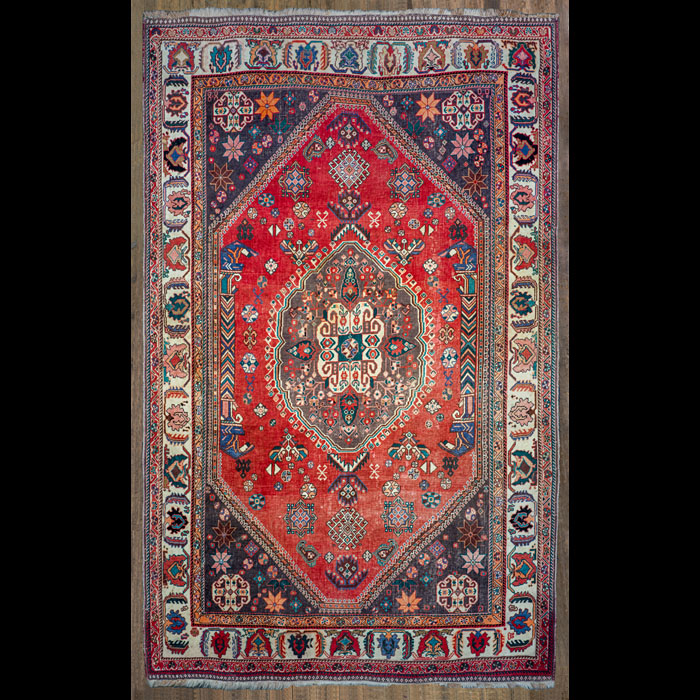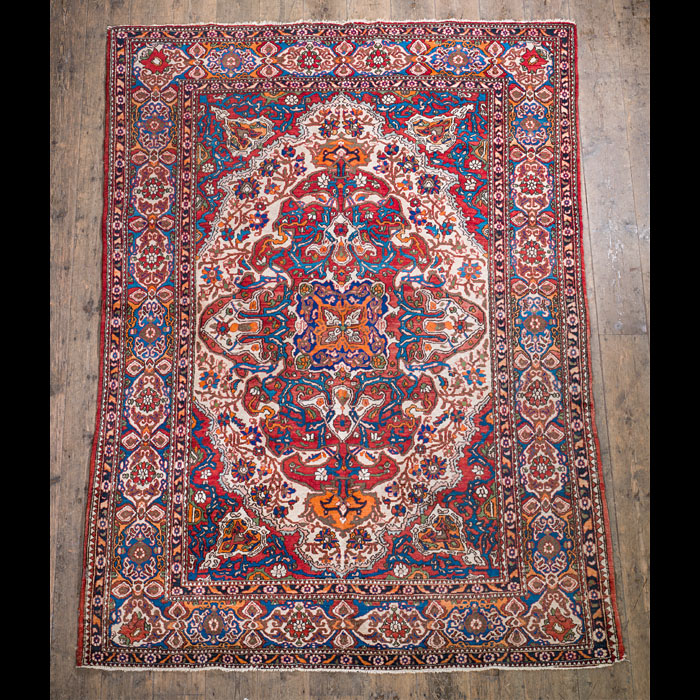-
 Sold
Sold
Stock: 16098
A vibrant Abadeh wool carpet from the Qashqai region of Iran, with a red ground typical of Qashqai carpets, a central cartouche and various floral motifs.
Notes: Qashqai carpets are coarse in nature and this makes them very hardwearing, and they are often made from both sheep and goat's wool and are coloured using natural dyes.
View our collection of: Carpets and rugs
|
Width |
Height |
|
|
98 3⁄8"
250 cms |
61 3⁄8"
156 cms |
|
|
|
|
|
-
 Sold
Sold
Stock: 15482
Abadeh carpet of large size, with flowerhead motifs on red ground, bordered by blue corners and a generous cream border, all profusely decorated with geometric and floral designs. Iranian, c.1950
Notes: Abadeh carpets were made in Abadeh, south Iran. They are easily recognised by their hexagonal central decoration with a red ground, bordered by blue corners. The ground of the border is oftem white, as are the four medallons in the corner.
Link to: Carpets and rugs
|
Length |
Width |
|
|
117 1⁄4"
298 cms |
79 1⁄2"
202 cms |
|
|
|
|
|
-
 Sold
Sold
Stock: 15483
A fine and very decorative Nahavand carpet, with geometric floral motifs on a bright red and blue ground, typical of Nomadic designs. Iranian, mid to late 20th century.
Notes: Navahand is a small province located in Western Iran and is one of the most prolific carpet making regions of Iran.
Link to: Carpets and rugs
|
Length |
Width |
|
|
82 11⁄16"
210 cms |
54 1⁄4"
138 cms |
|
|
|
|
|
-
 Sold
Sold
Stock: 15480
A decorative Afshar Persian carpet of relatively small proportions, the diamond shape central medallion framed by a golden border, echoed by similar tones throughout the floral decorative scheme. Iranian, c.1950.
The semi-nomadic Ashfar tribe originated in North-West Iran, but are now located in the South-East of the country.
Link to: Carpets and rugs
|
Length |
Width |
|
|
66 1⁄8"
168 cms |
57 7⁄8"
147 cms |
|
|
|
|
|
-
 Sold
Sold
Stock: 15478
A striking geometric Karajar carpet with three central medallions on a red ground, the border comprises a blue ground with nomadic style floral motifs. Iranian, c.1940.
Link to: Carpets and rugs
|
Length |
Width |
|
|
51 3⁄16"
130 cms |
40 3⁄16"
102 cms |
|
|
|
|
|
-
 Sold
Sold
Stock: 15392
A small Persian carpet with predominantly blue and russet red hues most probably an Afshar carpet. It is centred by a hexagonal enclosing geometric motifs framed by three foliate borders. The Turkic Afshar tribe, a semi-nomadic group, was mainly located in the northern region of Persia, now known as Azerbaijan. Part of the tribe was later resettled in the south eastern region in the Kerman district of the country and it was there that their work with carpets developed into a business. Persian, late 19th century.
Link to: Carpets and rugs
|
Width |
Height |
Depth |
|
80 1⁄4"
204 cms |
0 3⁄16"
0.4 cms |
40 7⁄8"
104 cms |
|
|
|
|
-
 Sold
Sold
Stock: 15258
A beautiful and very large Persian Kashan carpet. The central shaped panel with interlacing scrolled foliage and stylised flower heads woven in softly hued pale and midnight blues, magenta and ochre on an ivory ground. There are seven bands around the border of various repeating stylised flowers and motifs. Wool on a Cotton Base.
Persian, mid/late 20th century.
Kashan carpets are hand knotted and made in and around the town of Kashan in north west central Iran (Persia), 150 miles south of the capital, Tehran.
Link to: Carpets and rugs
|
Length |
Width |
|
|
139"
353 cms |
102 3⁄8"
260 cms |
|
|
|
|
|
-
 Sold
Sold
Stock: 15259
A fine twentieth century Nain woolwork carpet. Nain is a town east of Isfahan in what was once Persia and now Iran. It had for centuries been known for making cloaks with camel's wool, but in the early twentieth century used their fine woolwork skills to make rugs, often using cool colours, and elaborate geometric or floral designs. Nain carpets are made in such a way that the warp and weft are made of cotton, the pile made of wool and silk to make the motifs stand out.
Iranian, mid 20th century.
Link to: Carpets and Rags
|
Length |
Width |
|
|
125 3⁄16"
318 cms |
97 3⁄16"
247 cms |
|
|
|
|
|
-
 Sold
Sold
Stock: 15257
A mid twentieth century Isfahan carpet dominated by the central foliate medallion of intricate design surrounded by vines and flowers. These carpets are identified by the use of soft kork wool and silk woven in a very tight pile in red, magenta, blue or indigo on an ivory background.
The city of Isfahan is one of the finest in the Islamic world known for its wonderful Persian architecture. The carpets, woven here for centuries, are perhaps the best and most valuable to be found and are often inspired by the designs found in the buildings, gardens and palaces in this beautiful city. Persian, circa 1956.
View our collection of: Carpets and rugs
|
Length |
Width |
|
|
86 5⁄8"
220 cms |
56 1⁄4"
143 cms |
|
|
|
|
|
-
 Sold
Sold
Stock: 15254
A mid 20th century Bidjar carpet of woven floral motifs on a midnight blue background. These carpets have been made for centuries in and around the small Kurdish town of Bidjar, also known as Bijar, south of Tabriz in the northwest of Iran. They can be distinguished by their heavy wool or cotton foundation (cotton was used in the twentieth century). As the weaver ties each row of knots, an extra weft is added and pounded down. The stiff, heavy foundation that this creates allows the carpets to withstand up to many years of heavy use. Because of this they are known as “the iron rugs of Persia”. Persian, mid 1950s.
Link to: Carpets and rugs
|
Length |
Width |
|
|
83 1⁄8"
211 cms |
55 1⁄2"
141 cms |
|
|
|
|
|
-
 Sold
Sold
Stock: 15256
A Qashqai tribal carpet with a central midnight blue medallion filled and surrounded by a field of small floral motifs.
The Qashqai people, throughout their history, have been nomadic their tribes travelling hundreds of miles across the Middle East to winter near the Persian Gulf. Their history and culture is rich in both struggle and inspiration which greatly influences the designs and motifs found in their carpets and give them an unusual sense of spontaneity and aliveness. These carpets are usually woven by the women of the tribe who, defying the modern practice of using commercial dyes, continue to almost exclusively use natural vegetable and plant dyes and follow the more traditional weaving techniques. Their family carpets are greatly treasured and they have a saying: “Where I am is my carpet. Where my carpet and I am is my home.”
Persian, mid 1950s.
Link to: Carpets and rugs
|
Length |
Width |
|
|
94 1⁄8"
239 cms |
62 3⁄16"
158 cms |
|
|
|
|
|
Antique carpets can add much-needed warmth and texture to an interior. An antique carpet can come in numerous styles, from the minimalist geometry of a Berber carpet to the rich weave of an antique Persian carpet, there is something that will suit every room. As such, they can be used in many styles of interior and in many different rooms. Antique Kilim carpets are hard wearing and can suit rooms with high foot traffic, whereas a silky soft Kashan carpet is best preserved in a bedroom, or a room without high foot traffic.
Antique Persian carpets are perhaps the best known, renowned for their quality and variety of styles based on the region of manufacture. Antique Persian carpets are varied in design as different styles were developed by the numerous tribes of what is now modern-day Iran. Persian carpets were not always intended to be used on the floor, and silk weave carpets such as Kashan, Nain and Isfahan carpets were often displayed as wall hangings.
We have many antique carpets for sale, so please browse our collection or contact us for more information.